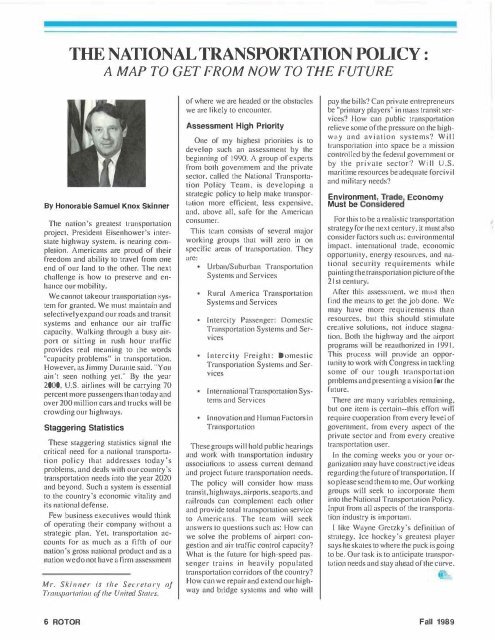Untitled - HFI Historical Archive - Helicopter Association International
Untitled - HFI Historical Archive - Helicopter Association International
Untitled - HFI Historical Archive - Helicopter Association International
You also want an ePaper? Increase the reach of your titles
YUMPU automatically turns print PDFs into web optimized ePapers that Google loves.
THE NATIONAL TRANSPORTATION POLICY:<br />
A MAP TO GET FROM NOW TO THE FUTURE<br />
By Honorable Samuel Knox Skinner<br />
The nation's greatest ll'allSportalion<br />
project, President Eisenhower's inler·<br />
state highway system. i!> nearing COIllpletion.<br />
Americ111ls are proud of their<br />
freedom and ability to trowel from one<br />
end of our land \0 the other. TIle next<br />
challenge is how [0 preserve and enhlLllce<br />
our mobility.<br />
We cnnnol lnkcour tnlllsporialion system<br />
for granted. We l11usl maintain and<br />
selectively expand our roads ,md transit<br />
systems and cnhllllce our air traffic<br />
capacity. Walking Ihrough a busy airport<br />
or sitting in rush hour Inlffic<br />
provides rcal mClIning to Ihe words<br />
"capacity problems" in tnmsl>ortalion.<br />
1'!owever,lIs Jimmy Duntll1c said, "YOll<br />
ain't seen nothing yet." By the year<br />
2000, U.S. airlines will be carrying 70<br />
percent more passengers than today and<br />
over 200 million cars :md trucks will be<br />
crowding our highways.<br />
Staggering Statistics<br />
These st:lggcring statistics signal the<br />
critic;11 need for a national transportation<br />
policy that addresses today's<br />
problems. and deals with our coumry's<br />
transportation needs into thc year 2020<br />
and beyond. Such a systcm is essential<br />
to the country's economic vitality and<br />
its nutional defense.<br />
Few business executives would think<br />
of operating their company without a<br />
strlltegic plan. Yet. transportation accounts<br />
for as much as a fifth of our<br />
Ilation's gross Ilational product and as a<br />
nation wedo not have:l firill assessment<br />
Mr. Skinner is lite Secretary of<br />
Transporlatioll oflhe Unired Slates.<br />
6 ROTOR<br />
of where we are headed or the obstacles<br />
we aTe likely to encounter.<br />
Assessment High Priority<br />
One of my highest priorities is to<br />
develop such an assessment by the<br />
beginning of 1990. A group of experts<br />
from both goveTllrncm and the private<br />
sector. called the N:ltion:d Transportation<br />
Pol icy Team. is developing a<br />
slr.ltegic policy to help make transpor<br />
\;Ition more efficient. less expensive.<br />
and. above nil. safe fOT the American<br />
consumer.<br />
nlis te,ull consists of several major<br />
working groups that will zero in on<br />
specific 'Ireas of transportation. They<br />
lire;<br />
Urb'lIl/Suburban Transportation<br />
Systems and Services<br />
Rural America Transportalioll<br />
Systems and Services<br />
[ntercity Passenger: Domestic<br />
Transportation Systems and Services<br />
Intercity Freight: Domestic<br />
Transportation Systcm and Services<br />
[ntemat ional TranslxlrIat ion S ystems<br />
and Services<br />
Innovation and Human F;lctors in<br />
Trunsport:ltion<br />
111ese groups wi II hold publ ic hearings<br />
und work with transportation industry<br />
associations to llssess current demand<br />
:md project future transportation needs.<br />
TIle policy will consider how mass<br />
t T:msil. h ighwa ys. ai rports. sell ports. and<br />
r:lilroads can complement each other<br />
and provide tOlal transponation service<br />
to Americlltls. The team will seek<br />
answers to questions such as: How can<br />
we solve the problems of 'Iirpon congestion<br />
and nil' traffic contro[ capncity?<br />
What is the future for high-speed passenger<br />
trains in heavily populated<br />
transportation corridors of the country?<br />
1·low can we rcpair:md extend our highway<br />
and bridge systems and who will<br />
pay the bi lis? em privilte entrepreneurs<br />
be "primary players" in llUlSS transit services?<br />
How can public tmnsportntion<br />
relieve some of the pressure on the highw:ly<br />
and aviation systems? Will<br />
trnnsponation into space be a mission<br />
contrtlilcd by the fedel'ill govcrnme11l or<br />
by the private sector'! Will U.S.<br />
maritime resources be :ldcqllflte forcivil<br />
and military needs?<br />
Environment, Trade j Economy<br />
Must be Considerea<br />
For this 10 be a renlistic transportation<br />
strategy forthe next century. it must :llso<br />
consider factors such ,IS: ellvironmental<br />
impact. international tT:lde. economic<br />
opportunity. energy resources. and national<br />
security requirements while<br />
painting the transportation picture of the<br />
21st century.<br />
After this assessment. we must then<br />
find the mellllS to get the job done. Wc<br />
may have more requirements th'lIl<br />
resources. bUI this should stimulate<br />
creOJtive solutions. lIot illduce stagnation.<br />
Both the highway :lnd the :lirport<br />
programs will be reauthorized in 1991.<br />
This pl'(x;c.s will provide an 0pl>or·<br />
\LInity to work with Congress in lackling<br />
some of our tough tr.lnsportation<br />
problems and present ing a vision lor the<br />
future.<br />
There are many variables remaining.<br />
but one item is certain--this effort will<br />
require cooperation from every level of<br />
government. rrom every aspect of the<br />
private sector and from every creative<br />
trans l >Oftation user.<br />
In the coming weeks you or your organization<br />
Illay have constructive ideas<br />
regarding the future of transportation. [f<br />
so please send them to me. OUTworking<br />
groups will seek to incorporate thcm<br />
into the National Transl>OT\illion Policy.<br />
Input from all aspects of the transportalion<br />
industry is illl l >onanl.<br />
[ like Wayne Grctzky's delinition of<br />
slnltegy. Ice hockey's greatest player<br />
says he skates to where thc puck is going<br />
to be. Our t:l5k is to anticipate transport:llion<br />
needs and stay ahe:ld of the curve.<br />
-,<br />
Il:=.<br />
Fall 1989


